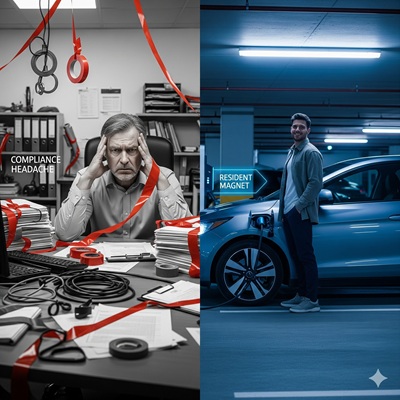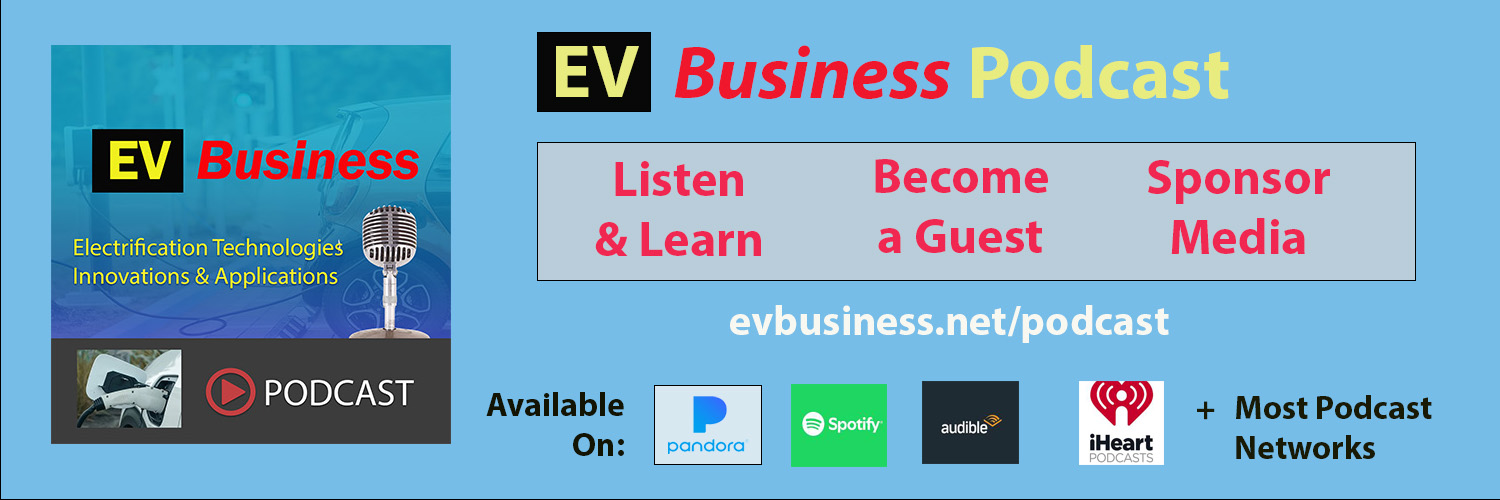By: Nas Jafari
Selecting, installing, and operating EV charging systems at apartment complexes is complicated, costly, and full of regulatory hurdles that many property owners and contractors are not prepared for. Yet what may surprise many is that shared EV chargers can increase tenant retention by over 31%, turning what once seemed like a liability into a long-term asset. Without proper load management, promotion to residents, and usage monitoring, however, EV chargers can create hidden costs—from low utilization and missed revenue to higher insurance premiums. This article explores the key benefits of EV charger installations, the biggest risks to avoid, and the smart system and service options that help apartment owners, electrical contractors, and industry professionals reduce costs, stay compliant, and unlock new value.

You want to discover more about EV Charging at Apartments? Listen to the podcast session that this article summarizes – EVBusiness.net/109. Also available on Spotify, Pandora, Audible, iHeartRadio & other podcast networks.
Tenant Stickiness, Future-Proofing, and Revenue Potential
EV drivers overwhelmingly prefer to charge at home, overnight, making apartment-based charging a natural fit when infrastructure is done right. Properties that add chargers retain residents more because EV charging convenience wins renewals. Beyond retention, EV-ready buildings appraise higher and lease faster. Charging stops being a cost center and becomes a differentiated asset that boosts occupancy, rent premiums, and new revenue. On-site charging locks in high-value residents for the long term, prepares properties for the inevitable rise in EV adoption, and creates recurring income when billing systems are in place.
Why “Smart Chargers” Are Non-Negotiable
In multi-dwelling units, unmanaged “plug-and-play” chargers may seem cheaper upfront, but networked smart AC chargers deliver far more long-term value. They prevent electrical overloads through load management and dynamic power sharing, enable accurate cost recovery with billing and access control via RFID, apps, or QR codes, and provide utilization, energy, and session analytics to guide decisions. With OCPP networking, they also offer vendor flexibility, remote management, and scalability—ensuring more chargers can be added without costly infrastructure upgrades. These capabilities directly shape ROI, safety, and risk management, making smart chargers the only sustainable choice for apartments.
Stakeholders and Project Management Challenges
For new builds, developers, builders, and electrical engineers must integrate the EV backbone—conduit, switchboard capacity, and communications—during early MEP design while coordinating with local authorities. In existing buildings, property managers, strata committees, and residents shape the requirements, while licensed electricians with EV commissioning experience translate them into scalable solutions. Identifying a “charging champion” within the committee and a clear point of contact on the management team shortens timelines and reduces miscommunication.
Projects often derail due to poor equipment selection, inconsistent compliance with codes, or misaligned stakeholder priorities. The solution is a structured process: requirements workshop, feasibility study, design basis report, committee approval, installation and commissioning, and finally a complete handover package including O&M manuals, training, and dashboards.
EV-Ready Architecture and Power Constraints
The right architecture is more important than the hardware itself. The backbone includes conduit and cable routes, switchboard capacity, and communications to support OCPP integration. The load management system monitors and controls how electricity is shared across multiple EV chargers, preventing overloads and protecting the building’s electrical system. It also optimises energy use and ensures all vehicles receive a fair share of power efficiently. Access control keeps sessions limited to authorized drivers.
The most common fear is whether the building has enough power. In practice, dynamic load management means the answer is often yes, even without full panel or transformer upgrades. More residents can charge safely on the same infrastructure, enabling smooth scaling from pilot projects to full deployments.
Implementation Roadmap and Safety Requirements
A typical project takes three to six months from residents and strata committee agreement to install ev chargers. The process begins with aligning expectations on access rules and pricing, followed by a feasibility study assessing capacity, and charger selection. Licensed electricians carry out the installation, while EV charging commissioning specialists handle the integration of the load management and billing systems, followed by comprehensive testing. Safety is paramount—insist on certified brands, licensed installers, appropriate fire protection devices, and annual preventative maintenance.
Operations, Billing, and Shared Use Logistics
After the chargers are commissioned and go live, the management dashboard becomes a critical tool for overseeing all aspects of EV charging. It allows building managers to monitor each charging session in real time, track charger status, generate revenue reports, and receive alerts for any faults or issues. Preventative maintenance is essential to ensure long-term reliability and safety, including annual inspections of connectors, cables, signage, and firmware updates to keep the system running smoothly. Equally important is resident education: providing a clear charging guide along with QR codes linking to safety instructions helps residents use the chargers correctly, prevents misuse, and reduces the risk of damage or downtime. Together, these measures maximise the efficiency, safety, and return on investment of the EV charging infrastructure.
Billing can be user-pays, flat-rate, or a hybrid model, with transparency building resident trust. Shared-use chargers require reservation tools, anti-ICEing signage, bollards, and idle fees to keep them available, efficient, and fair for everyone.
Financing, Incentives, and Energy Optimization
To lower CapEx barriers, properties can access grants, rebates, and utility programs or adopt Charging-as-a-Service models where operators fund and manage the infrastructure. Financing and investor partnerships can spread costs while charging revenue helps amortize investments. For added efficiency, chargers can be paired with solar PV, battery storage, and time-of-use optimization, reducing energy costs and boosting sustainability.
Measuring Success and Long-Term Value
Success is measured by utilization rates, resident satisfaction, and ROI. Well-managed properties often achieve payback in 24-36 months, not including the added value of higher lease renewals and faster unit absorption. Insurers may adjust premiums for electrification, but using certified equipment, maintenance schedules, and transparent documentation often keeps costs in check.
Build It Right, and It Pays You Back
Apartment EV charging succeeds when approached like a systems integration project: scalable design, robust load management, transparent billing, and thorough training. With the right plan, EV charging transforms from a regulatory headache into a resident magnet and a durable revenue stream.

About Nas Jafari
Nas Jafari is Managing Director at Future Charging. Ms. Jafari is a specialist in EV chargers for multi-unit residences and commercial properties, focusing on making electric vehicle charging accessible and efficient for apartment communities and businesses. Nas has over 10 years of leadership and development experience in renewable energy solutions, EV infrastructure deployment, and sustainable technology integration.


